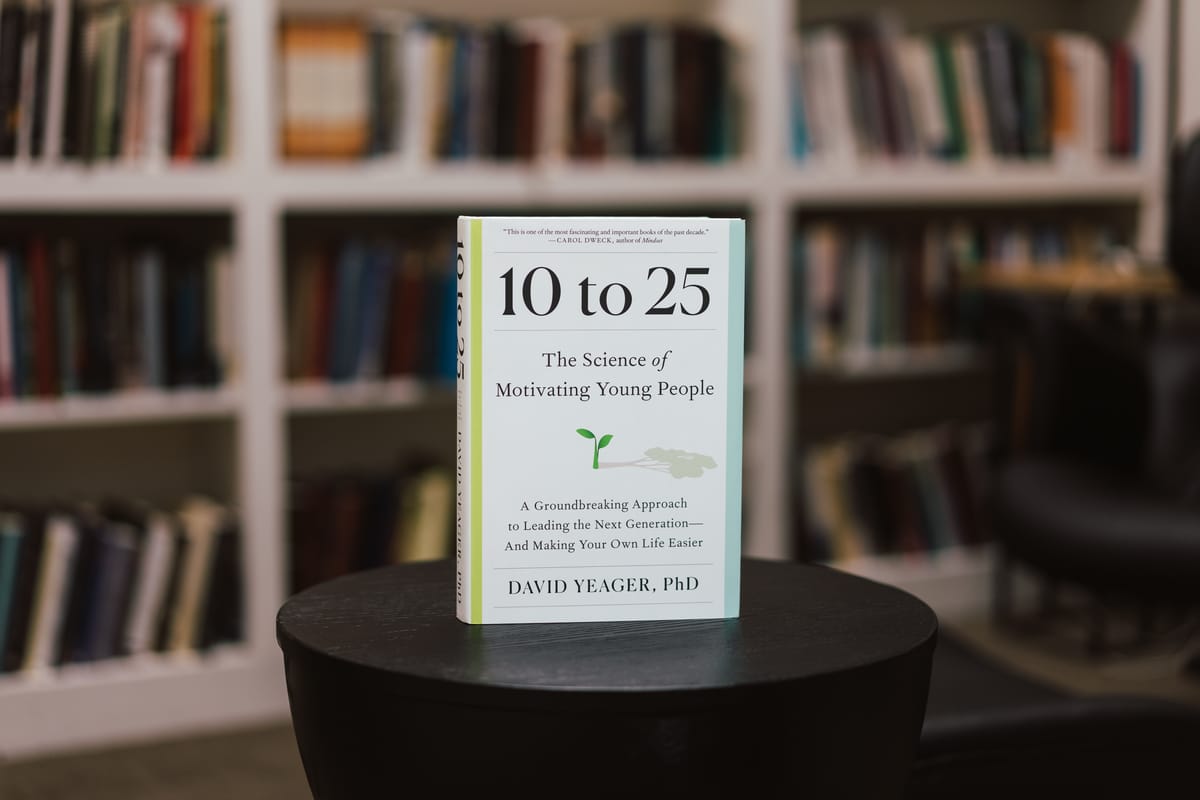Review of David Yeager's 10 to 25: The Science of Motivating Young People
Yeager’s mentor mindset—high standards paired with high support—rejects the false choice between demanding rigor without help and lowering the bar. It makes challenge a compliment and support a sign of respect.

Many parents, teachers, coaches, and employers spend enormous energy managing adolescents yet rarely pause to respect them (oftentimes unintentionally). We treat teen emotions like problems to fix, raise alarms over screen addiction (rightly), and double down on control. But in doing so, we often fail to cultivate their potential, framing them instead as fragile and fundamentally unready for real responsibility. David Yeager’s 10 to 25 argues that this dismissal, not teenage biology, creates most of the friction between generations. His central idea challenges the common view of adolescence as naturally difficult. Instead, he argues that “young people deploy their considerable cognitive resources to attend to and protect their immediate social status and respect.” Teenagers enter every conversation with adults listening for signals of disrespect, trying to decode what adults really think of them. When those signals suggest incompetence, they shut down or rebel. When they convey genuine respect plus meaningful challenge, even hard work can feel like progress toward adulthood.
Yeager, a social psychologist who has spent twenty years studying how adolescents develop, makes his case with careful research and obvious fondness for young people. He challenges what he calls the “neurobiological-incompetence model,” the idea that teenagers are basically broken adults whose brains haven’t finished developing. Against this deficit view, Yeager shows that “youth are not problems to be managed but instead are resources to be cultivated.” The supposed irrationality of adolescence, he argues, comes not from faulty biology but from adults failing to meet young people’s core need: “status and respect from peers and mentors, earned by making meaningful contributions.”
His main insight centers on what he calls the mentor mindset, an approach that combines “high standards plus high support,” giving young people “a route to status and respect” rather than protecting them from difficulty or overwhelming them with impossible expectations. This differs from two more common but less effective approaches: the enforcer mindset (high standards, low support) that treats every mistake as a character flaw, and the protector mindset (low standards, high support) that offers comfort while quietly suggesting young people can’t handle real challenges.
Enforcers typically demand excellence but offer little help (think of the professor who assigns impossible work then blames students for failing). Protectors provide endless support but lower the bar (the boss who assigns only easy tasks to avoid stress). Neither approach works because both miss what people in this age range typically actually want: the chance to do something difficult that matters. As Yeager puts it, “An effective mentor creates opportunities for young people to learn about, and begin to acquire, what counts for status in a valued social group.”
I have high standards, and I know you can meet them…
Yeager opens with a test case that is simply a single sentence written across student essays. In New York secondary schools, he asked teachers to grade papers exactly as they always had and then add one line at the top: I have high standards, and I know you can meet them. Nothing else changed.
Students who read that sentence rewrote more thoughtfully, trusted their teachers more deeply, and earned higher grades months later. The intervention cost nothing and took seconds, yet it dissolved what Yeager calls the “barrier of mistrust” that often separates adolescent effort from adult feedback.
The experiment showed what good feedback actually is, not empty encouragement but what Stanford psychologist Geoffrey Cohen called breaking through “the barrier of mistrust.” This barrier affects people with less power when their competence gets questioned; they “tend to assume the most unfavorable and antagonistic reasons” for what authority figures do. When their status feels threatened, young people “will dissect each word, looking for deeper meaning,” focusing “more on the unsaid part than the said part.” The single sentence cut through this mistrust by stating both respect and expectations clearly.
The Truth Campaign
A similar principle appears at national scale in Yeager’s account of the Truth campaign against teenage smoking. Through the 1990s, anti-tobacco ads had bombarded adolescents with diseased lungs and mortality statistics but smoking rates climbed anyway. The warnings carried an implicit message teenagers heard clearly: You’re too immature to make good choices. Truth flipped the script entirely, as one campaign executive explained: “Young people are not idiots. They make decisions about what’s valuable to them, so it’s our job to make nonsmoking a valuable decision, on their terms.”
An up and coming advertising agency argue for a different approach (and they somehow won the bid). They created TV ads that leaked tobacco industry memos, billboards that stacked body bags outside corporate headquarters, all with a central message: They lie. We expose. This helped transformed abstinence into righteous rebellion. Not smoking became a mark of rebellion from young people rather than compliance. As Yeager notes, the campaign succeeded by showing that “young people can in fact make choices that are good for their long-term health if we give them a route to status and respect.” Teen smoking rates dropped. Teenage rebellion didn’t disappear but it was simply shifted for better work.
The Myth of “Stress is Debilitating”
Yeager also spent considerable time rethinking how we handle pressure. Drawing on Stanford psychologist Alia Crum’s research, he separates stressors (the actual demands we face) from stress responses (how we interpret those demands). The common “stress-is-debilitating belief” mixes these up, leading to a “protector mindset” that removes challenges instead of building the ability to meet them. But a racing heartbeat and sweaty hands can actually sharpen focus when people understand it as fuel rather than a warning sign. Combine that insight with Carol Dweck’s growth mindset (the belief that ability grows through effort) and you get what Yeager calls “synergistic mindsets”: difficulty signals potential, and adrenaline provides the energy to reach it.
One particularly helpful example illustrates this principle through Hawi, an honors senior whose mother died six weeks before final exams. Some professors urged withdrawal; others insisted on business as usual. Her mentor-minded instructor chose a third path: “The professor maintained the high standard for the most meaningful part of the course (the final project) but supported Hawi by relieving her of most small assignments.” More importantly, the professor emphasized that “during a time of crisis, doing something that matters to you and the world around you can provide a sense of meaning that can help you cope with stress.” Hawi completed an excellent study on humane school discipline, graduated on time, and carried the project to job interviews at major consulting firms. The lesson isn’t that grief becomes manageable but that rigor and sympathy can coexist when respect speaks first.
Reflection and Challenge
Even the most skillful mentoring falls short if young people never claim their efforts as part of their emerging identity. Psychologists James Youniss and Miranda Yates demonstrated that volunteer hours predict adult civic engagement only when teenagers pause to reflect on why the service aligns with their values. Yeager tested this insight at a North Carolina summer camp for students from high-achieving charter schools. Counselors highlighted campers' displays of tenacity (conquering a ropes course) and purpose (mentoring younger peers) as they occurred, revisited these moments with them each evening, and the students wrote detailed letters cataloging both qualities on the final day.
Most importantly, campers then wrote essays connecting their zip-line courage to previous classroom fears (the terror of raising a hand in algebra, the risk of seeming foolish in front of friends). They revisited these connections three months later, cementing the links between physical bravery and intellectual boldness. Five years later, participants were ten percentage points more likely to enroll in four-year colleges than peers who spent the same week in traditional academic enrichment. As Yeager explains, “The more youth reflected and therefore consolidated their experience into an identity, the better the long-term results.” Reflection, properly framed and anchored to meaningful challenge, had transformed seven days into a self-portrait that guided five years of choices.
The Risk of Simplification
Throughout, Yeager gaurds against his suggetions from becoming simple slogans. The mentor mindset isn’t a quick fix but a thoughtful response to competing truths about human development. As he notes, “The different styles don’t solely come from immutable characteristics or ossified childhood experiences. They come, in part, from people’s beliefs. Because beliefs can be changed, then so too can the way we lead and inspire young people.” Enforcers aren’t wrong to worry about chaos and protectors aren’t wrong to worry about harm. But only mentors address both concerns without insulting young people’s basic competence. Standards alone create resentment while support alone suggests incompetence. Together, they create what the Māori culture calls whakamana, giving someone prestige through real opportunity.
This earned prestige, according to Yeager, is the most powerful human reward: longer-lasting than dominance, more satisfying than applause, more motivating than external pressure. It solves what he calls “the adolescent predicament,” which he defines as “the mismatch between young people’s neurobiological needs for status and respect and the level of status or respect afforded to them by their current circumstances.” This predicament shows up “any time you experience a change in roles, when you transition from one set of expectations and job descriptions to another, when status is on the line.”
The Mentor Mindset for Future Growth
Yeager concludes with wisdom from Ralph Cornell, one of California’s most influential landscape architects of the 20th center, who said, “a well-designed garden plans for future growth. A designer needs to imagine what a tree or a shrub will look like fully grown, not what it looks like on the day it’s planted.” The mentor mindset operates on the same principle: “When we mentor for future growth, it’s far better to give young people experiences that show them they are capable of meeting the high standard with the appropriate support, rather than offering them unfounded assurances of their abilities or, worse, hiding the standards from them altogether.”
10 to 25 reads like the work of someone who has spent real time with young people, not as problems to solve but as people to develop. Yeager writes with the careful precision of his academic background without losing sight of what actually matters. He repeats his main ideas often, sometimes more than needed, but the repetition serves a purpose: being clear is itself a form of respect.
Yeager asks the key question: “What if the problem has more to do with us and how we treat the next generation than it has to do with who they are?” His answer offers a better path: recognizing that teenagers aren’t broken adults but developing people hungry for meaningful challenges. They want to climb higher. Give them a ladder worth climbing, put your hands on the rungs beside them, and promise they belong on the way up, and they’ll rise, often higher than anyone expected.
Young people are not problems to be managed but partners to be trusted with work that matters. The mentor mindset doesn’t just change how we treat the next generation. It changes how they see themselves, and ultimately, what they become. As educator Kurt Hahn observed decades ago, there are three ways to win the young: “You can preach at them: that is a hook without a worm. You can say, You must volunteer, and that is of the devil. You can tell them, You are needed. That appeal hardly ever fails.”
This book deserves a place on the desk of anyone who works with this age group, whether in classrooms, leadership trainings, or living rooms. Yeager has written something special: a book grounded in rigorous science that actually helps you see younger people in your life differently. You’ll finish it with practical tools for giving better feedback, a clearer understanding of why our well-meaning approaches sometimes backfire, and renewed faith in young people’s capacity to rise to meaningful challenges. In a culture quick to blame adolescents for everything from declining test scores to social media addiction, Yeager offers something more valuable than blame or pity. He offers respect, and shows us how to give it in ways that matter.
Key Quotes
- “Here’s the takeaway. When you hold young people to high standards and make it clear that you believe they can meet those standards, you are respecting them because you are taking them seriously. Young people rise to meet the challenge because being respected is motivating. Further, you lift up all students and see greater equity.”
- “Any time young people interact with socially powerful people—managers, parents, educators, or coaches—status and respect come to the foreground. Because young people feel sensitive to differences in status, they are subtly reading between the lines with each thing we say, trying to interpret the hidden implications of our words, to find out if we are disrespecting or honoring them. This creates a pervasive disconnect between what adults intend to communicate when we speak and what young people can hear from our words.”
- “We owe it to young people to ask the hard question: What if the problem has more to do with us—and how we treat the next generation—than it has to do with who they are?”
- “Over the last two decades, a scientific revolution has been brewing in the study of young people. It’s pushed back against the neurobiological-incompetence model. This revolution asserts that youth are not problems to be managed but instead are resources to be cultivated.”
- “What lessons can we take from the story of the ‘Truth’ campaign? It shows that young people can in fact make choices that are good for their long-term health if we give them a route to status and respect. ‘Young people are not idiots,’ the current CEO of the ‘Truth’ initiative told me. ‘They make decisions about what’s valuable to them, so it’s our job to make nonsmoking a valuable decision, on their terms.’ Instead of trying to get young people to care less about status or respect and more about their long-term self-interest, we should spend more time figuring out how to present choices to them in a way that aligns with the social rewards they already value.”
- “Young people deploy their considerable cognitive resources to attend to and protect their immediate social status and respect. If the information they get from adults threatens their social survival by robbing them of the status and respect they crave, they’ll likely tune it out. This isn’t because they’re immature. It’s because it’s part of learning how to survive.”
- “The third way, the mentor mindset, is to have high standards plus high support. Upholding high standards can help maintain order and prevent the feared descent into chaos. Simultaneously, the high levels of support convey how much we care for young people. By taking young people seriously and giving them the support they need to earn impressive reputations, we give them a route to status and respect. They get to earn prestige, which they need far more than a self-esteem puff-up.”
- “An effective mentor creates opportunities for young people to learn about, and begin to acquire, what counts for status in a valued social group.”
- “The barrier of mistrust helps explain the frustrating generational divide. It’s a war over meaning. Mistrust makes young people subtly read between the lines of each comment their elders make, trying to interpret the hidden implications of our words, to determine if we are disrespecting them or not. Young people focus more on the unsaid part than the said part.”
- “When we mentor for future growth, it’s far better to give young people experiences that show them they are capable of meeting the high standard with the appropriate support, rather than offering them unfounded assurances of their abilities—or, worse, hiding the standards from them altogether.”




